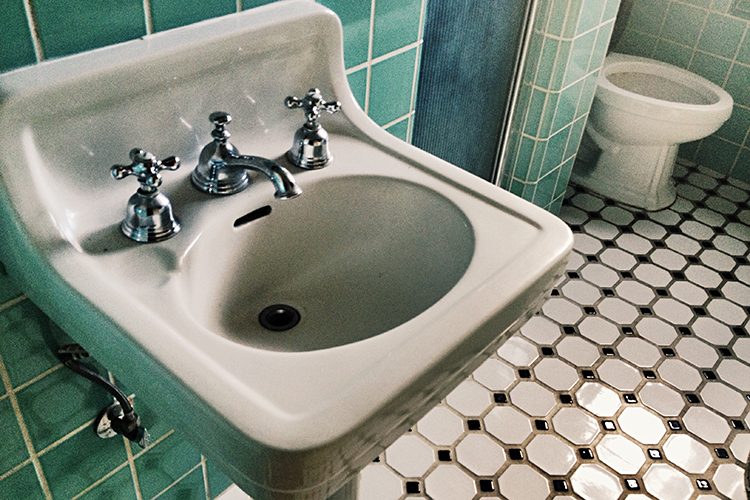Exploring Plumbing Innovations Through the Years
Plumbing manufacturers improve safety, convenience and water efficiency while keeping up with homeowners’ changing tastes.

Paul Symmons invented the thermostatic valve that protects us today from getting scalded from rapid water temperature changes in the shower. Codes and standards contribute to the safe and consistent operation of plumbing fixtures and fittings. Advanced leak detection systems help save homeowners from costly water damage while enhancing water efficiency.
These are only a few of the many plumbing innovations that have improved the lives of people around the world. And plumbing manufacturers are ready to accomplish more.
Plumbing Manufacturers International (PMI) members have led the way and continue to meet changing customer tastes and design trends while advocating for safe drinking water.
How Tastes and Tech Have Changed
American homeowners keep raising the bar when considering their kitchen and bathroom wants and needs. For example, utilitarian indoor bathroom spaces fitted simply with a toilet, tub and sink can be transformed into high-tech, spa-like rooms today.
Advances in new plumbing technology enable homeowners to update their bathrooms and kitchens how they prefer. Plumbing manufacturers offer abundant new shapes and finishes for water-efficient toilets, faucets and showerheads to meet the public’s aspirations for comfort, durability and beauty.
For example, homeowners can still choose a single, fixed showerhead or integrate a variety of showerhead alternatives, such as hand-held, rainfall and body sprays.
Americans enjoy convenience, and the latest smart showers deliver. Some PMI members produce state-of-the-art experiences using Wi-Fi and voice activation to turn on a shower, set ideal personal water temperatures, and even program the length of time for the shower to run.
Smart faucets have quickly risen in popularity. Using infrared technology, these faucets allow users to turn on the water by simply moving their hands in front of them. Recently, smart faucets got smarter and offer voice-controlled demands for temperature adjustment and precisely measured amounts of water.
Leak detection has come a long way, too. Water damage costs homeowners billions of dollars annually. PMI members engineer leak-detection systems that save homeowners time, money and precious water. The latest systems use machine learning to better understand and analyze water usage patterns, provide live updates on a home’s flow rate and water pressure, and automatically shut off water when a leak is detected.
Outdoor sprinkler systems even integrate weather monitoring to control outdoor water use.
Then, there are the bolder advanced innovations plumbing manufacturers create. For example, PMI member TOTO has taken the toilet to a new level. The company showcased its Wellness Toilet at the Consumer Electronics Show in 2021, intending to launch the product for residential bathrooms in a few years.
The toilet uses cutting-edge sensing technologies, including artificial intelligence, to support consumers’ wellness by tracking and analyzing their physical status. The toilet’s sensors scan the body and key outputs and make wellness-improvement recommendations using a smartphone app.
Elevating Product Dependability
PMI members have a rich history of designing admirable plumbing safety features that they continue to improve upon.
For example, the thermostatic valve invented by Paul Symmons in 1939 changed the dynamic in showers. The valve design, still the standard today, delivers safe and consistent shower temperatures and has led to extensive changes in plumbing codes to improve safety, reports PMI member Symmons.
Similarly, Al Moen altered faucets with his single-handle invention that mixed hot and cold water to reduce the chance of scalding. Moen was inspired to make faucets safer after he burned his hands using a two-handle faucet in 1937. His single-handle faucets began rolling off the manufacturing line in 1947. Fortune magazine named PMI member Moen’s single-handle faucet one of the best-designed, mass-produced products of modern times in 1959.
Even the smallest things can make a big difference. For example, plumbing manufacturers discovered that rubber fittings in older faucets would wear out and cause leaks. Their solution? Designing ceramic disks to eliminate drips, making products more reliable.
The modern bathroom has evolved with health and hygiene concerns — especially during outbreaks of cholera, influenza and other infectious diseases. The COVID-19 pandemic created high demand for touchless faucets and toilets. PMI members have amped up their innovations by increasingly using materials that resist bacteria growth, and created self-cleaning toilets and sinks designed to drain water quickly.
Updated Codes and Standards Keep the Public Safe
Plumbing codes and standards create a framework for good health and safety by establishing minimum standards for the design, installation, modification and repair of plumbing systems.
The plumbing industry collaborates around standard codes to ensure the safe and consistent operation of fixtures and fittings. These efforts produce uniformity so plumbing products work together to be installed in any home — delivering real progress.
As safe, clean water becomes more of a public concern, the U.S. plumbing and building code community continues to grow. Several PMI members participate in developing and updating standards and codes for plumbing products and materials, and products that treat or come into contact with drinking water.
For example, PMI members IAPMO and the International Code Council (ICC) publish two of the most widely used model codes over the last 50 to 100 years. IAPMO develops the Uniform Plumbing Code (UPC), originally published in 1945, in accordance with the ANSI due process requirements for American National Standards.
ICC develops the International Plumbing Code (IPC) and other essential codes. The UPC and IPC provide the foundation for state, city and municipal codes. IAPMO and ICC revise and update the UPC and IPC on a three-year development cycle.
Water Efficiency Rises In Importance
As climate change continues to trigger long-term droughts nationwide, plumbing manufacturers are stepping up to produce water-efficient plumbing fixtures.
The U.S. Environmental Protection Agency’s WaterSense program provides one of the strongest examples of how plumbing manufacturers joined together to support the efficient use of water and protect the environment.
Many PMI members join with the 2,100 manufacturers, retailers, builders and others who participate in the program and produce the more than 42,000 WaterSense products on the market today. They helped save more than 1.1 trillion gallons of water in 2022 and more than 7.5 trillion gallons since the program started in 2006.
Plumbing innovations are often overlooked and taken for granted. However, the plumbing manufacturing and allied industries understand the importance of making advancements to improve the public’s quality of life — with safe, reliable plumbing fixtures that deliver clean, healthy water. We can’t wait to see what plumbing manufacturers come up with next.
Kerry Stackpole, FASAE, CAE, is the CEO/executive director of Plumbing Manufacturers International. Stackpole has spent more than three decades leading trade associations in manufacturing, technology and services. Contact him at kstackpole@safeplumbing.org.




